HI5020 Corporate Accounting: Financial Statement Analysis of CBA & NAB
VerifiedAdded on 2023/06/07
|23
|4408
|280
Report
AI Summary
This report provides a comparative analysis of Commonwealth Bank of Australia (CBA) and National Australia Bank (NAB), focusing on key aspects of corporate accounting. It examines owners' equity, including ordinary share capital, other equity instruments, reserves, and retained profits, highlighting changes and trends in these components. The report also analyzes cash flow statements, detailing operating, investing, and financing activities, and compares the net cash flows and free cash flows of both banks. Furthermore, it discusses accounting for corporate income tax, including the differences between effective tax rates and deferred tax assets. The analysis uses data from the companies' annual reports to assess their financial positions and performance.

Running Head: CORPORATE ACCOUNTING 0
Corporate Accounting
Corporate Accounting
Paraphrase This Document
Need a fresh take? Get an instant paraphrase of this document with our AI Paraphraser
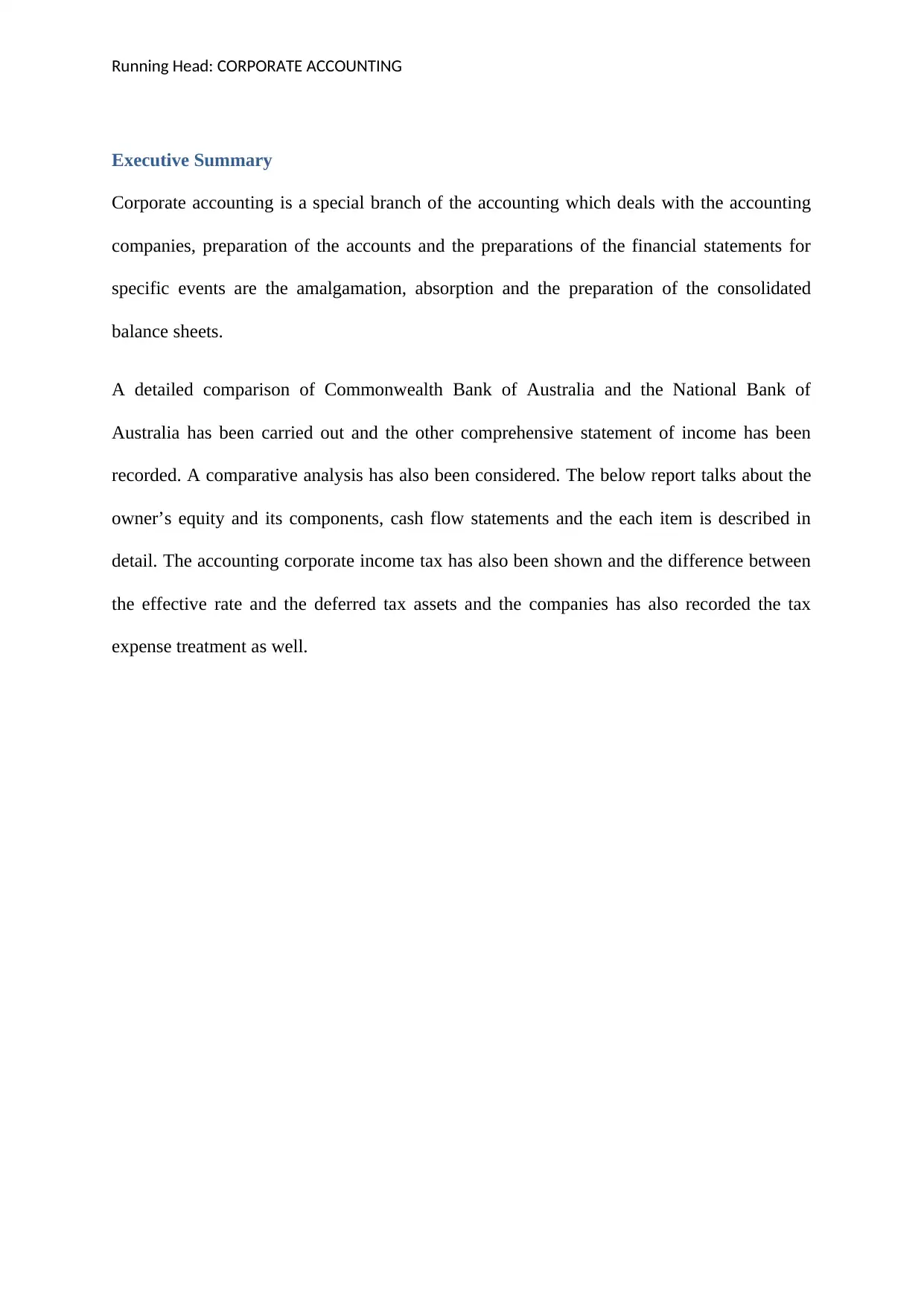
Running Head: CORPORATE ACCOUNTING
Executive Summary
Corporate accounting is a special branch of the accounting which deals with the accounting
companies, preparation of the accounts and the preparations of the financial statements for
specific events are the amalgamation, absorption and the preparation of the consolidated
balance sheets.
A detailed comparison of Commonwealth Bank of Australia and the National Bank of
Australia has been carried out and the other comprehensive statement of income has been
recorded. A comparative analysis has also been considered. The below report talks about the
owner’s equity and its components, cash flow statements and the each item is described in
detail. The accounting corporate income tax has also been shown and the difference between
the effective rate and the deferred tax assets and the companies has also recorded the tax
expense treatment as well.
Executive Summary
Corporate accounting is a special branch of the accounting which deals with the accounting
companies, preparation of the accounts and the preparations of the financial statements for
specific events are the amalgamation, absorption and the preparation of the consolidated
balance sheets.
A detailed comparison of Commonwealth Bank of Australia and the National Bank of
Australia has been carried out and the other comprehensive statement of income has been
recorded. A comparative analysis has also been considered. The below report talks about the
owner’s equity and its components, cash flow statements and the each item is described in
detail. The accounting corporate income tax has also been shown and the difference between
the effective rate and the deferred tax assets and the companies has also recorded the tax
expense treatment as well.
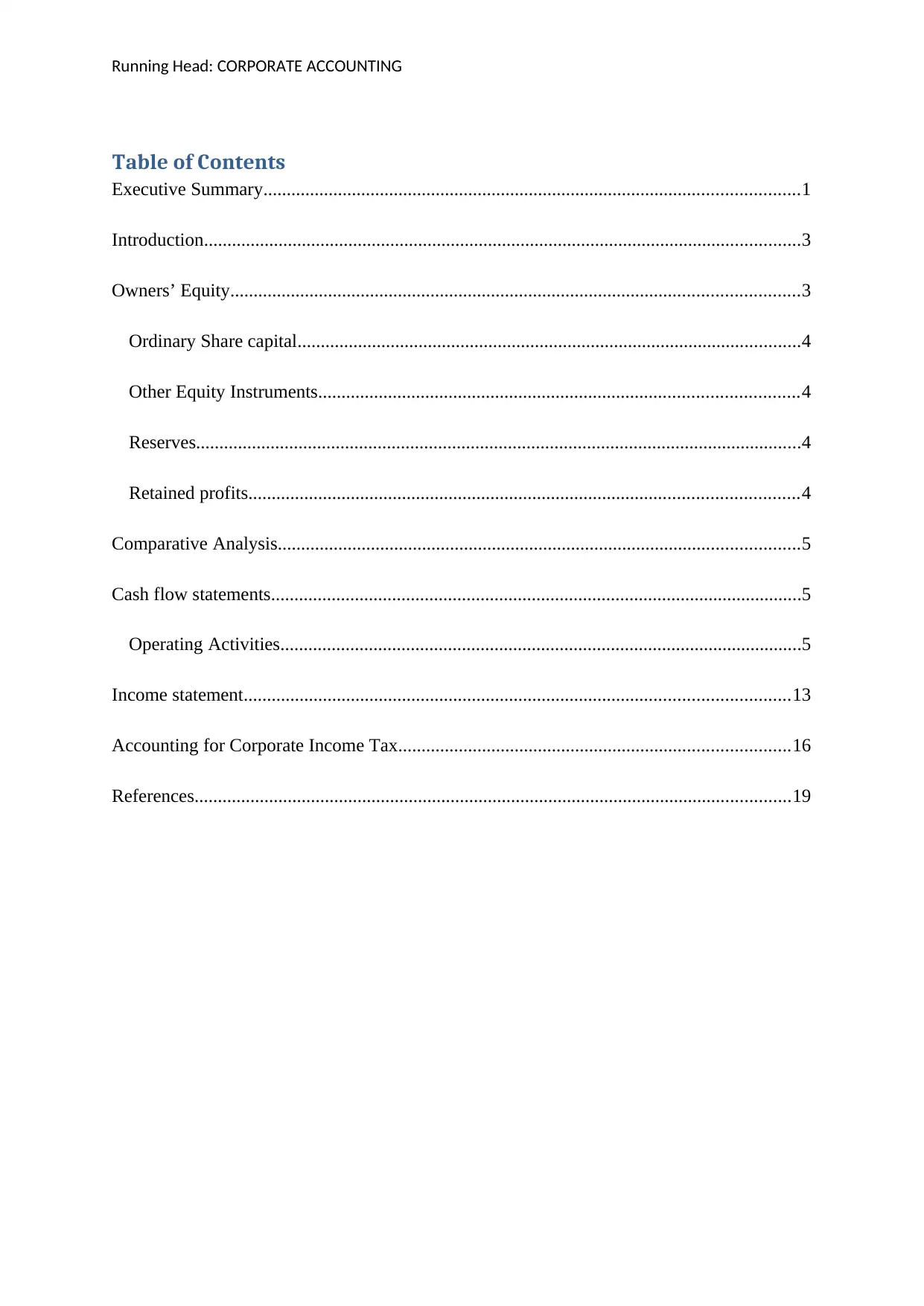
Running Head: CORPORATE ACCOUNTING
Table of Contents
Executive Summary...................................................................................................................1
Introduction................................................................................................................................3
Owners’ Equity..........................................................................................................................3
Ordinary Share capital............................................................................................................4
Other Equity Instruments.......................................................................................................4
Reserves..................................................................................................................................4
Retained profits......................................................................................................................4
Comparative Analysis................................................................................................................5
Cash flow statements..................................................................................................................5
Operating Activities................................................................................................................5
Income statement.....................................................................................................................13
Accounting for Corporate Income Tax....................................................................................16
References................................................................................................................................19
Table of Contents
Executive Summary...................................................................................................................1
Introduction................................................................................................................................3
Owners’ Equity..........................................................................................................................3
Ordinary Share capital............................................................................................................4
Other Equity Instruments.......................................................................................................4
Reserves..................................................................................................................................4
Retained profits......................................................................................................................4
Comparative Analysis................................................................................................................5
Cash flow statements..................................................................................................................5
Operating Activities................................................................................................................5
Income statement.....................................................................................................................13
Accounting for Corporate Income Tax....................................................................................16
References................................................................................................................................19
⊘ This is a preview!⊘
Do you want full access?
Subscribe today to unlock all pages.

Trusted by 1+ million students worldwide
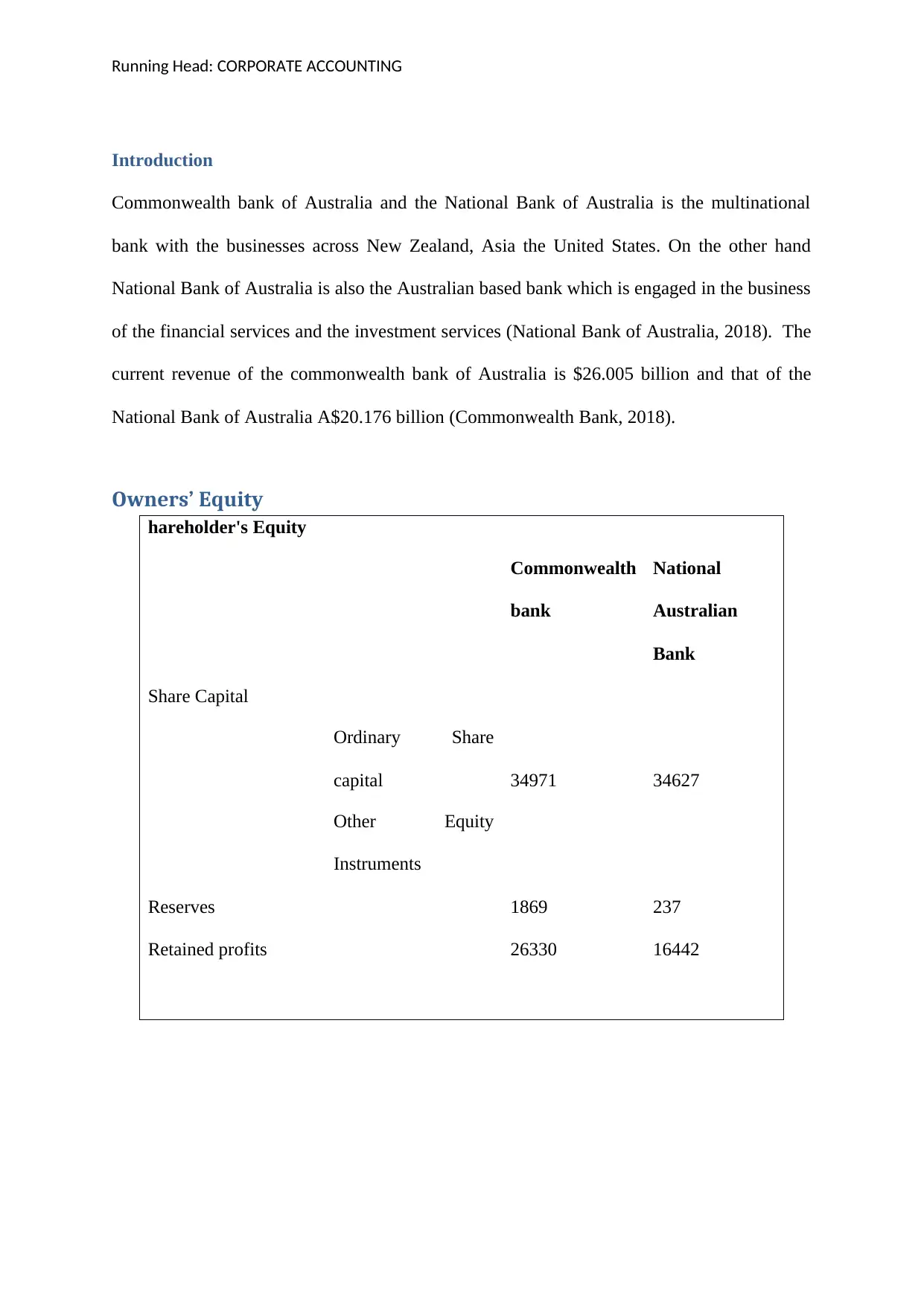
Running Head: CORPORATE ACCOUNTING
Introduction
Commonwealth bank of Australia and the National Bank of Australia is the multinational
bank with the businesses across New Zealand, Asia the United States. On the other hand
National Bank of Australia is also the Australian based bank which is engaged in the business
of the financial services and the investment services (National Bank of Australia, 2018). The
current revenue of the commonwealth bank of Australia is $26.005 billion and that of the
National Bank of Australia A$20.176 billion (Commonwealth Bank, 2018).
Owners’ Equity
hareholder's Equity
Commonwealth
bank
National
Australian
Bank
Share Capital
Ordinary Share
capital 34971 34627
Other Equity
Instruments
Reserves 1869 237
Retained profits 26330 16442
Introduction
Commonwealth bank of Australia and the National Bank of Australia is the multinational
bank with the businesses across New Zealand, Asia the United States. On the other hand
National Bank of Australia is also the Australian based bank which is engaged in the business
of the financial services and the investment services (National Bank of Australia, 2018). The
current revenue of the commonwealth bank of Australia is $26.005 billion and that of the
National Bank of Australia A$20.176 billion (Commonwealth Bank, 2018).
Owners’ Equity
hareholder's Equity
Commonwealth
bank
National
Australian
Bank
Share Capital
Ordinary Share
capital 34971 34627
Other Equity
Instruments
Reserves 1869 237
Retained profits 26330 16442
Paraphrase This Document
Need a fresh take? Get an instant paraphrase of this document with our AI Paraphraser
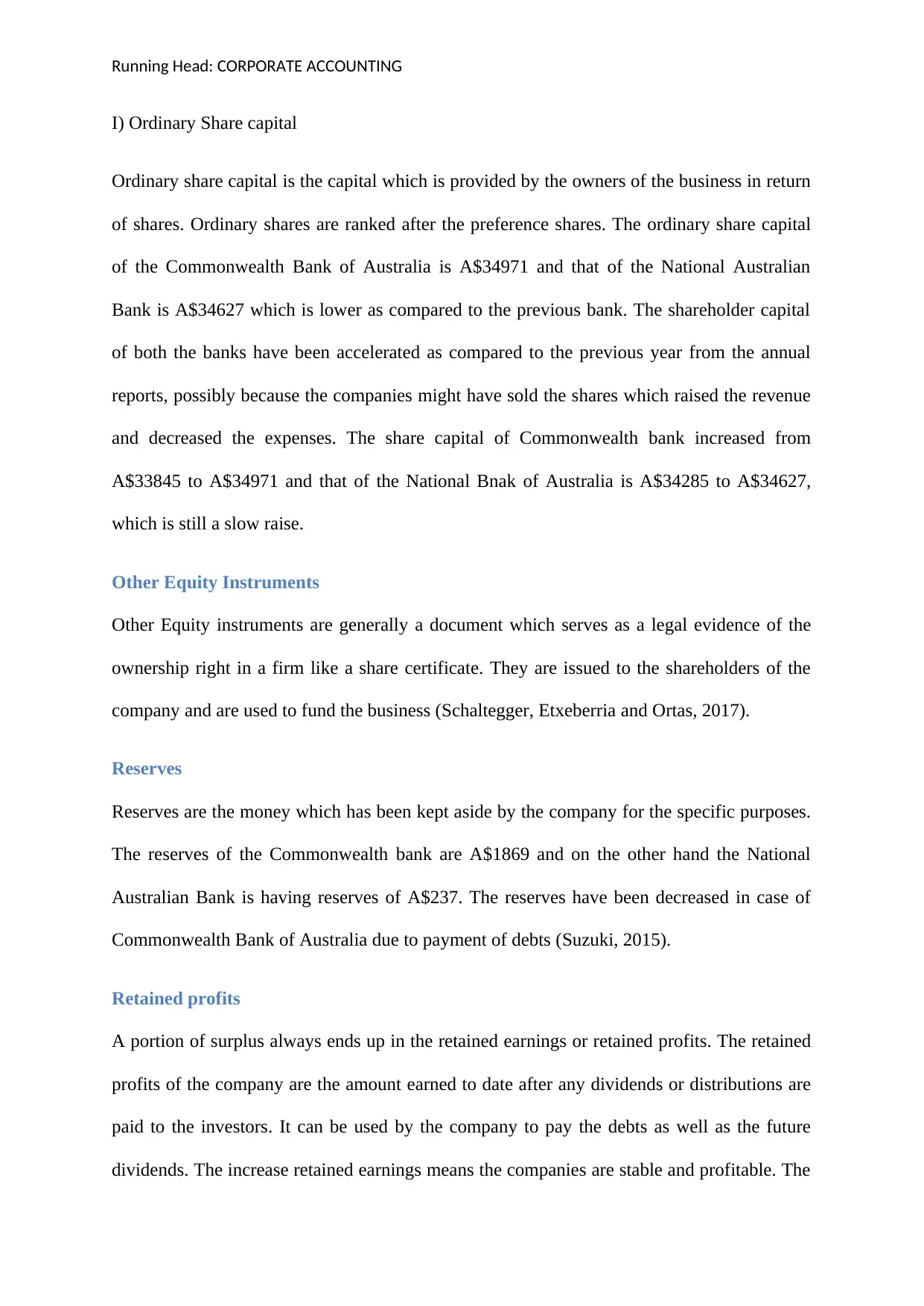
Running Head: CORPORATE ACCOUNTING
I) Ordinary Share capital
Ordinary share capital is the capital which is provided by the owners of the business in return
of shares. Ordinary shares are ranked after the preference shares. The ordinary share capital
of the Commonwealth Bank of Australia is A$34971 and that of the National Australian
Bank is A$34627 which is lower as compared to the previous bank. The shareholder capital
of both the banks have been accelerated as compared to the previous year from the annual
reports, possibly because the companies might have sold the shares which raised the revenue
and decreased the expenses. The share capital of Commonwealth bank increased from
A$33845 to A$34971 and that of the National Bnak of Australia is A$34285 to A$34627,
which is still a slow raise.
Other Equity Instruments
Other Equity instruments are generally a document which serves as a legal evidence of the
ownership right in a firm like a share certificate. They are issued to the shareholders of the
company and are used to fund the business (Schaltegger, Etxeberria and Ortas, 2017).
Reserves
Reserves are the money which has been kept aside by the company for the specific purposes.
The reserves of the Commonwealth bank are A$1869 and on the other hand the National
Australian Bank is having reserves of A$237. The reserves have been decreased in case of
Commonwealth Bank of Australia due to payment of debts (Suzuki, 2015).
Retained profits
A portion of surplus always ends up in the retained earnings or retained profits. The retained
profits of the company are the amount earned to date after any dividends or distributions are
paid to the investors. It can be used by the company to pay the debts as well as the future
dividends. The increase retained earnings means the companies are stable and profitable. The
I) Ordinary Share capital
Ordinary share capital is the capital which is provided by the owners of the business in return
of shares. Ordinary shares are ranked after the preference shares. The ordinary share capital
of the Commonwealth Bank of Australia is A$34971 and that of the National Australian
Bank is A$34627 which is lower as compared to the previous bank. The shareholder capital
of both the banks have been accelerated as compared to the previous year from the annual
reports, possibly because the companies might have sold the shares which raised the revenue
and decreased the expenses. The share capital of Commonwealth bank increased from
A$33845 to A$34971 and that of the National Bnak of Australia is A$34285 to A$34627,
which is still a slow raise.
Other Equity Instruments
Other Equity instruments are generally a document which serves as a legal evidence of the
ownership right in a firm like a share certificate. They are issued to the shareholders of the
company and are used to fund the business (Schaltegger, Etxeberria and Ortas, 2017).
Reserves
Reserves are the money which has been kept aside by the company for the specific purposes.
The reserves of the Commonwealth bank are A$1869 and on the other hand the National
Australian Bank is having reserves of A$237. The reserves have been decreased in case of
Commonwealth Bank of Australia due to payment of debts (Suzuki, 2015).
Retained profits
A portion of surplus always ends up in the retained earnings or retained profits. The retained
profits of the company are the amount earned to date after any dividends or distributions are
paid to the investors. It can be used by the company to pay the debts as well as the future
dividends. The increase retained earnings means the companies are stable and profitable. The
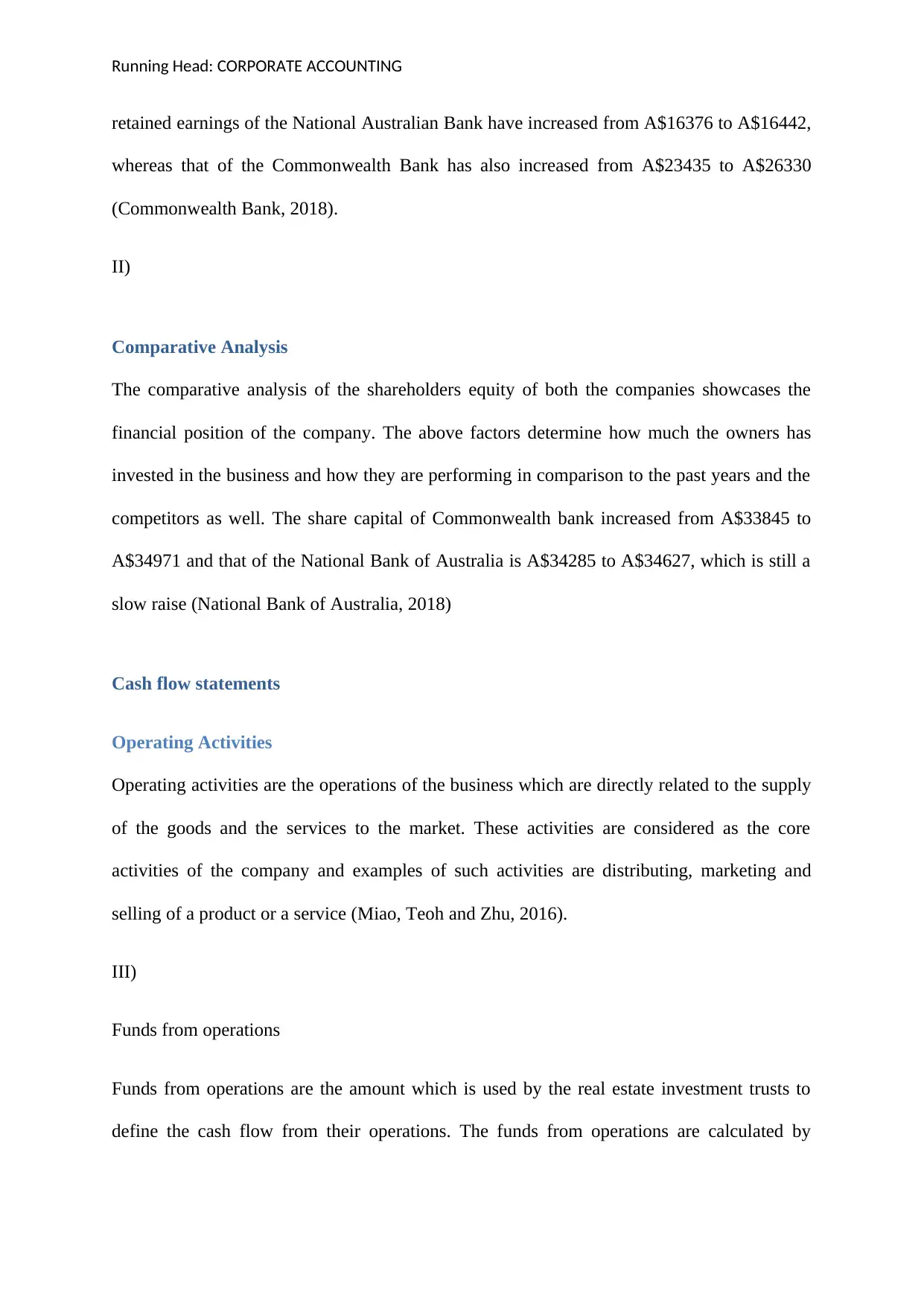
Running Head: CORPORATE ACCOUNTING
retained earnings of the National Australian Bank have increased from A$16376 to A$16442,
whereas that of the Commonwealth Bank has also increased from A$23435 to A$26330
(Commonwealth Bank, 2018).
II)
Comparative Analysis
The comparative analysis of the shareholders equity of both the companies showcases the
financial position of the company. The above factors determine how much the owners has
invested in the business and how they are performing in comparison to the past years and the
competitors as well. The share capital of Commonwealth bank increased from A$33845 to
A$34971 and that of the National Bank of Australia is A$34285 to A$34627, which is still a
slow raise (National Bank of Australia, 2018)
Cash flow statements
Operating Activities
Operating activities are the operations of the business which are directly related to the supply
of the goods and the services to the market. These activities are considered as the core
activities of the company and examples of such activities are distributing, marketing and
selling of a product or a service (Miao, Teoh and Zhu, 2016).
III)
Funds from operations
Funds from operations are the amount which is used by the real estate investment trusts to
define the cash flow from their operations. The funds from operations are calculated by
retained earnings of the National Australian Bank have increased from A$16376 to A$16442,
whereas that of the Commonwealth Bank has also increased from A$23435 to A$26330
(Commonwealth Bank, 2018).
II)
Comparative Analysis
The comparative analysis of the shareholders equity of both the companies showcases the
financial position of the company. The above factors determine how much the owners has
invested in the business and how they are performing in comparison to the past years and the
competitors as well. The share capital of Commonwealth bank increased from A$33845 to
A$34971 and that of the National Bank of Australia is A$34285 to A$34627, which is still a
slow raise (National Bank of Australia, 2018)
Cash flow statements
Operating Activities
Operating activities are the operations of the business which are directly related to the supply
of the goods and the services to the market. These activities are considered as the core
activities of the company and examples of such activities are distributing, marketing and
selling of a product or a service (Miao, Teoh and Zhu, 2016).
III)
Funds from operations
Funds from operations are the amount which is used by the real estate investment trusts to
define the cash flow from their operations. The funds from operations are calculated by
⊘ This is a preview!⊘
Do you want full access?
Subscribe today to unlock all pages.

Trusted by 1+ million students worldwide
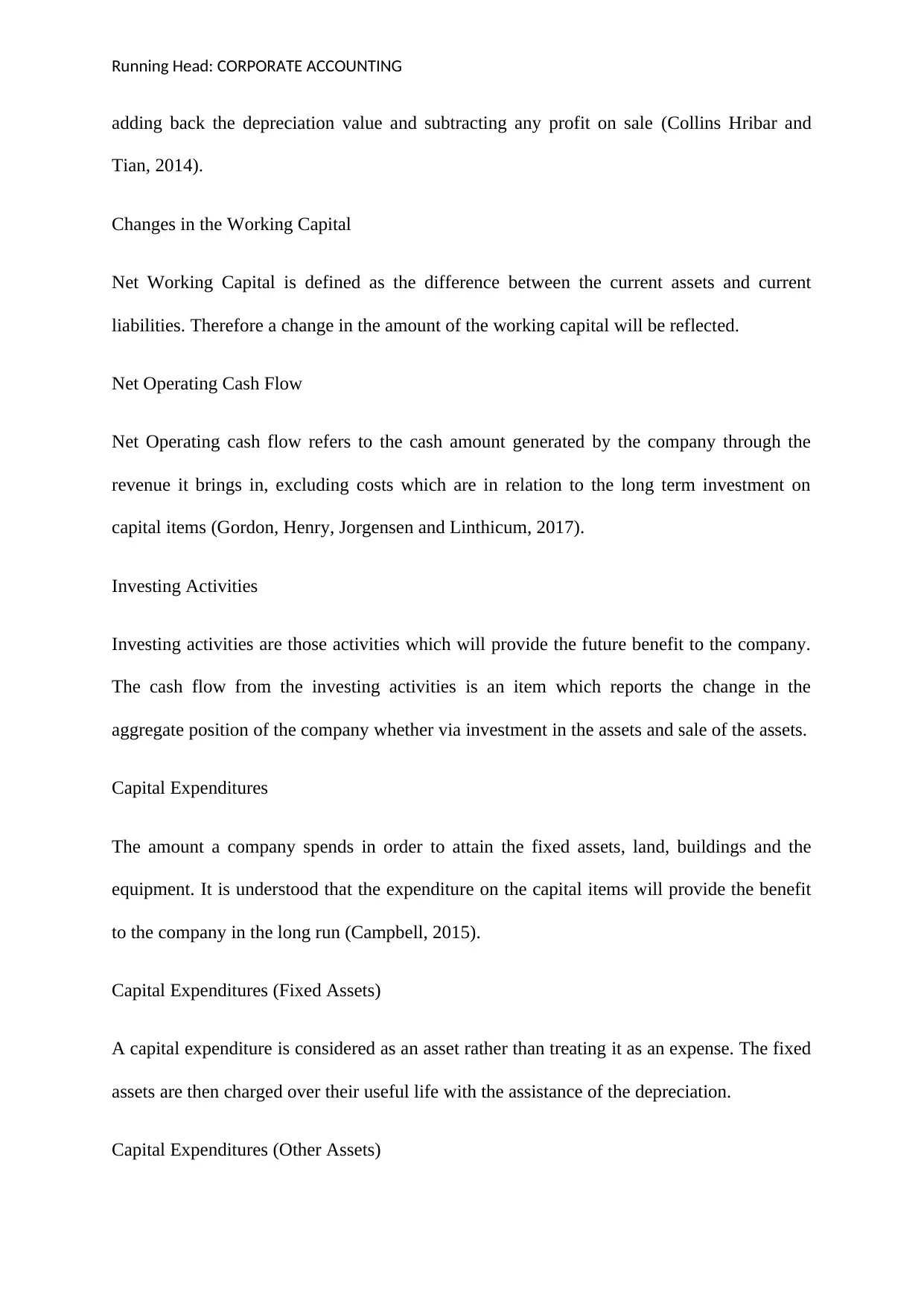
Running Head: CORPORATE ACCOUNTING
adding back the depreciation value and subtracting any profit on sale (Collins Hribar and
Tian, 2014).
Changes in the Working Capital
Net Working Capital is defined as the difference between the current assets and current
liabilities. Therefore a change in the amount of the working capital will be reflected.
Net Operating Cash Flow
Net Operating cash flow refers to the cash amount generated by the company through the
revenue it brings in, excluding costs which are in relation to the long term investment on
capital items (Gordon, Henry, Jorgensen and Linthicum, 2017).
Investing Activities
Investing activities are those activities which will provide the future benefit to the company.
The cash flow from the investing activities is an item which reports the change in the
aggregate position of the company whether via investment in the assets and sale of the assets.
Capital Expenditures
The amount a company spends in order to attain the fixed assets, land, buildings and the
equipment. It is understood that the expenditure on the capital items will provide the benefit
to the company in the long run (Campbell, 2015).
Capital Expenditures (Fixed Assets)
A capital expenditure is considered as an asset rather than treating it as an expense. The fixed
assets are then charged over their useful life with the assistance of the depreciation.
Capital Expenditures (Other Assets)
adding back the depreciation value and subtracting any profit on sale (Collins Hribar and
Tian, 2014).
Changes in the Working Capital
Net Working Capital is defined as the difference between the current assets and current
liabilities. Therefore a change in the amount of the working capital will be reflected.
Net Operating Cash Flow
Net Operating cash flow refers to the cash amount generated by the company through the
revenue it brings in, excluding costs which are in relation to the long term investment on
capital items (Gordon, Henry, Jorgensen and Linthicum, 2017).
Investing Activities
Investing activities are those activities which will provide the future benefit to the company.
The cash flow from the investing activities is an item which reports the change in the
aggregate position of the company whether via investment in the assets and sale of the assets.
Capital Expenditures
The amount a company spends in order to attain the fixed assets, land, buildings and the
equipment. It is understood that the expenditure on the capital items will provide the benefit
to the company in the long run (Campbell, 2015).
Capital Expenditures (Fixed Assets)
A capital expenditure is considered as an asset rather than treating it as an expense. The fixed
assets are then charged over their useful life with the assistance of the depreciation.
Capital Expenditures (Other Assets)
Paraphrase This Document
Need a fresh take? Get an instant paraphrase of this document with our AI Paraphraser

Running Head: CORPORATE ACCOUNTING
The other assets include the current assets and probably the advance from the customers and
the deposits. The cost or the values of an asset is adjusted for the purpose of the tax.
Net Assets from Acquisitions
The net assets from acquisitions are basically the amount which is arrived after adding up all
the above assets and expenditures.
Sale of Fixed Assets & Businesses
The sale of the fixed assets is a normal process which is undertaken either to gain an
advantage when the price is right and can enables the earnings and profits or when the part of
the asset or an entire asset becomes useless. The sale of the business also involves transfer of
the ownership to the other party (Weber, 2018).
Purchase/Sale of Investments
Generally the investment transactions are made through the brokers and the purchase of the
investment is done basically to secure the company. The right market price or the favourable
market price when arrives the company sells the investment.
Financing Activities
The financing activities involve the transactions with creditors or investors. These activities
help in either expansion of the operations of the company or help the existing operations.
These transactions are the third set of the activities which are used while forming the cash
flow statement.
The examples of the financing activities are Cash Dividends Paid – Total, Common
Dividends, Cash Dividend Growth, Change in Capital Stock, Repurchase of Common &
Preferred Stock, Sale of Common & Preferred Stock, Proceeds from Stock Options,
The other assets include the current assets and probably the advance from the customers and
the deposits. The cost or the values of an asset is adjusted for the purpose of the tax.
Net Assets from Acquisitions
The net assets from acquisitions are basically the amount which is arrived after adding up all
the above assets and expenditures.
Sale of Fixed Assets & Businesses
The sale of the fixed assets is a normal process which is undertaken either to gain an
advantage when the price is right and can enables the earnings and profits or when the part of
the asset or an entire asset becomes useless. The sale of the business also involves transfer of
the ownership to the other party (Weber, 2018).
Purchase/Sale of Investments
Generally the investment transactions are made through the brokers and the purchase of the
investment is done basically to secure the company. The right market price or the favourable
market price when arrives the company sells the investment.
Financing Activities
The financing activities involve the transactions with creditors or investors. These activities
help in either expansion of the operations of the company or help the existing operations.
These transactions are the third set of the activities which are used while forming the cash
flow statement.
The examples of the financing activities are Cash Dividends Paid – Total, Common
Dividends, Cash Dividend Growth, Change in Capital Stock, Repurchase of Common &
Preferred Stock, Sale of Common & Preferred Stock, Proceeds from Stock Options,

Running Head: CORPORATE ACCOUNTING
Issuance/Reduction of Debt, Net, Change in Long-Term Debt, Issuance of Long-Term Debt,
Reduction in Long-Term Debt, Other Funds and sources (Huang, Lin and Raghunandan,
2015).
Net Change in Cash
The net change in the cash reflects the increase or decrease in the cash and the cash
equivalents from the starting point to the end point of a year. The net change is calculated as
a result of cash from operating, investing and the financing activities (Graham and Lin,
2018).
Free Cash Flow
The free cash flow is measured by how much amount of the cash the company is able to
generate after paying off for all the expenses and can be used for the expansion, dividends,
reduction of the debts and for other purposes (Free cash flow, 2017).
From the cash flow below it can be analysed and observed that in case of the Commonwealth
bank the net cash from operating activities has been improved and reached to 2.651 from
0.841 as compared to the previous year mainly because of the increase in the funds from
operations and that of the National Australian Bank have been reduced to 569 from (2327),
the company is trying to improve (Talebnia, Jaberzadeh and Salehi, 2015)
Net cash flow from the investing activities
IV)
Cash flow Statement Commonwealth Bank National Australian
Bank
Fiscal year is July-June. All 2018 2017 2016 2018 2017 2016
Issuance/Reduction of Debt, Net, Change in Long-Term Debt, Issuance of Long-Term Debt,
Reduction in Long-Term Debt, Other Funds and sources (Huang, Lin and Raghunandan,
2015).
Net Change in Cash
The net change in the cash reflects the increase or decrease in the cash and the cash
equivalents from the starting point to the end point of a year. The net change is calculated as
a result of cash from operating, investing and the financing activities (Graham and Lin,
2018).
Free Cash Flow
The free cash flow is measured by how much amount of the cash the company is able to
generate after paying off for all the expenses and can be used for the expansion, dividends,
reduction of the debts and for other purposes (Free cash flow, 2017).
From the cash flow below it can be analysed and observed that in case of the Commonwealth
bank the net cash from operating activities has been improved and reached to 2.651 from
0.841 as compared to the previous year mainly because of the increase in the funds from
operations and that of the National Australian Bank have been reduced to 569 from (2327),
the company is trying to improve (Talebnia, Jaberzadeh and Salehi, 2015)
Net cash flow from the investing activities
IV)
Cash flow Statement Commonwealth Bank National Australian
Bank
Fiscal year is July-June. All 2018 2017 2016 2018 2017 2016
⊘ This is a preview!⊘
Do you want full access?
Subscribe today to unlock all pages.

Trusted by 1+ million students worldwide
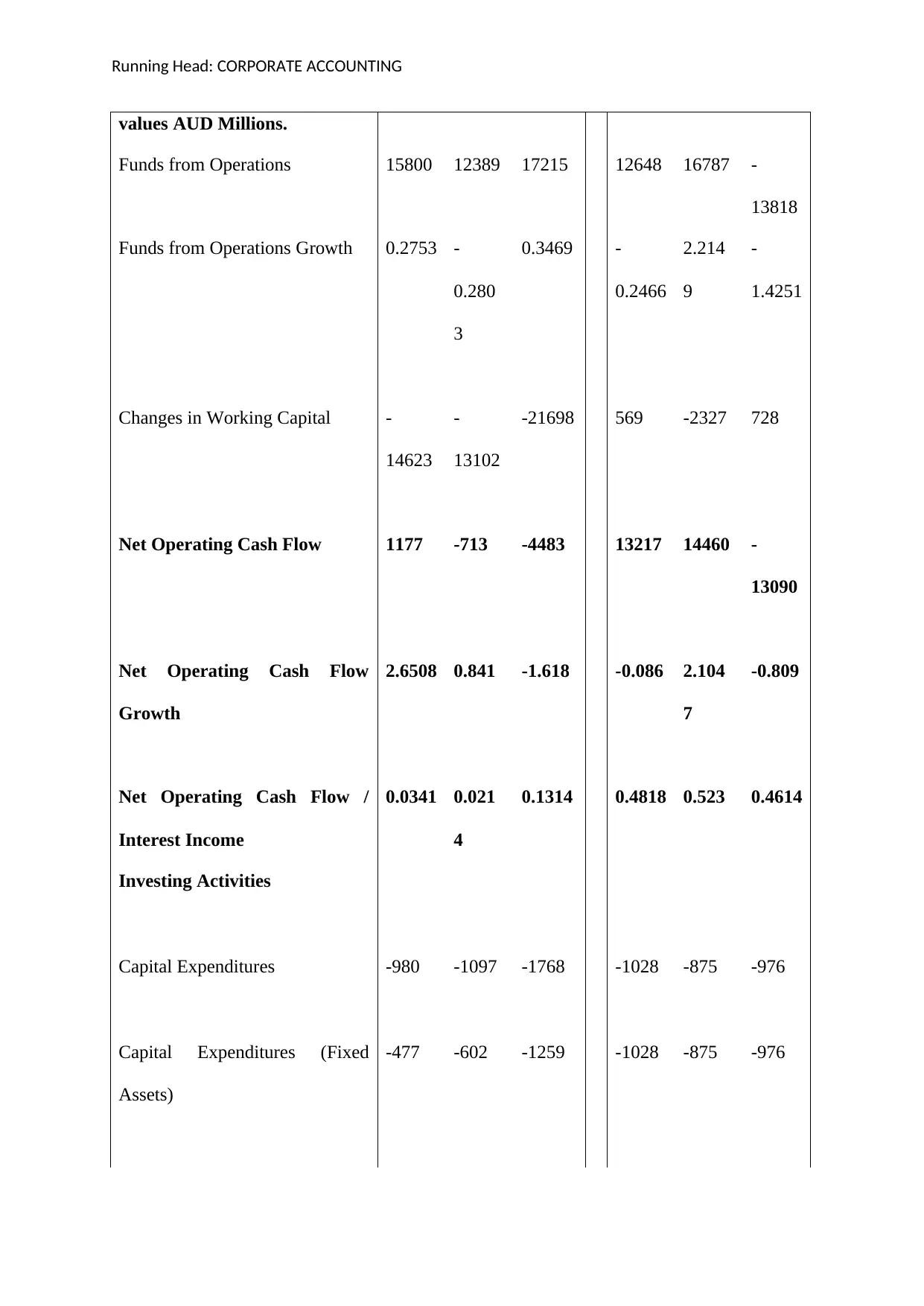
Running Head: CORPORATE ACCOUNTING
values AUD Millions.
Funds from Operations 15800 12389 17215 12648 16787 -
13818
Funds from Operations Growth 0.2753 -
0.280
3
0.3469 -
0.2466
2.214
9
-
1.4251
Changes in Working Capital -
14623
-
13102
-21698 569 -2327 728
Net Operating Cash Flow 1177 -713 -4483 13217 14460 -
13090
Net Operating Cash Flow
Growth
2.6508 0.841 -1.618 -0.086 2.104
7
-0.809
Net Operating Cash Flow /
Interest Income
0.0341 0.021
4
0.1314 0.4818 0.523 0.4614
Investing Activities
Capital Expenditures -980 -1097 -1768 -1028 -875 -976
Capital Expenditures (Fixed
Assets)
-477 -602 -1259 -1028 -875 -976
values AUD Millions.
Funds from Operations 15800 12389 17215 12648 16787 -
13818
Funds from Operations Growth 0.2753 -
0.280
3
0.3469 -
0.2466
2.214
9
-
1.4251
Changes in Working Capital -
14623
-
13102
-21698 569 -2327 728
Net Operating Cash Flow 1177 -713 -4483 13217 14460 -
13090
Net Operating Cash Flow
Growth
2.6508 0.841 -1.618 -0.086 2.104
7
-0.809
Net Operating Cash Flow /
Interest Income
0.0341 0.021
4
0.1314 0.4818 0.523 0.4614
Investing Activities
Capital Expenditures -980 -1097 -1768 -1028 -875 -976
Capital Expenditures (Fixed
Assets)
-477 -602 -1259 -1028 -875 -976
Paraphrase This Document
Need a fresh take? Get an instant paraphrase of this document with our AI Paraphraser
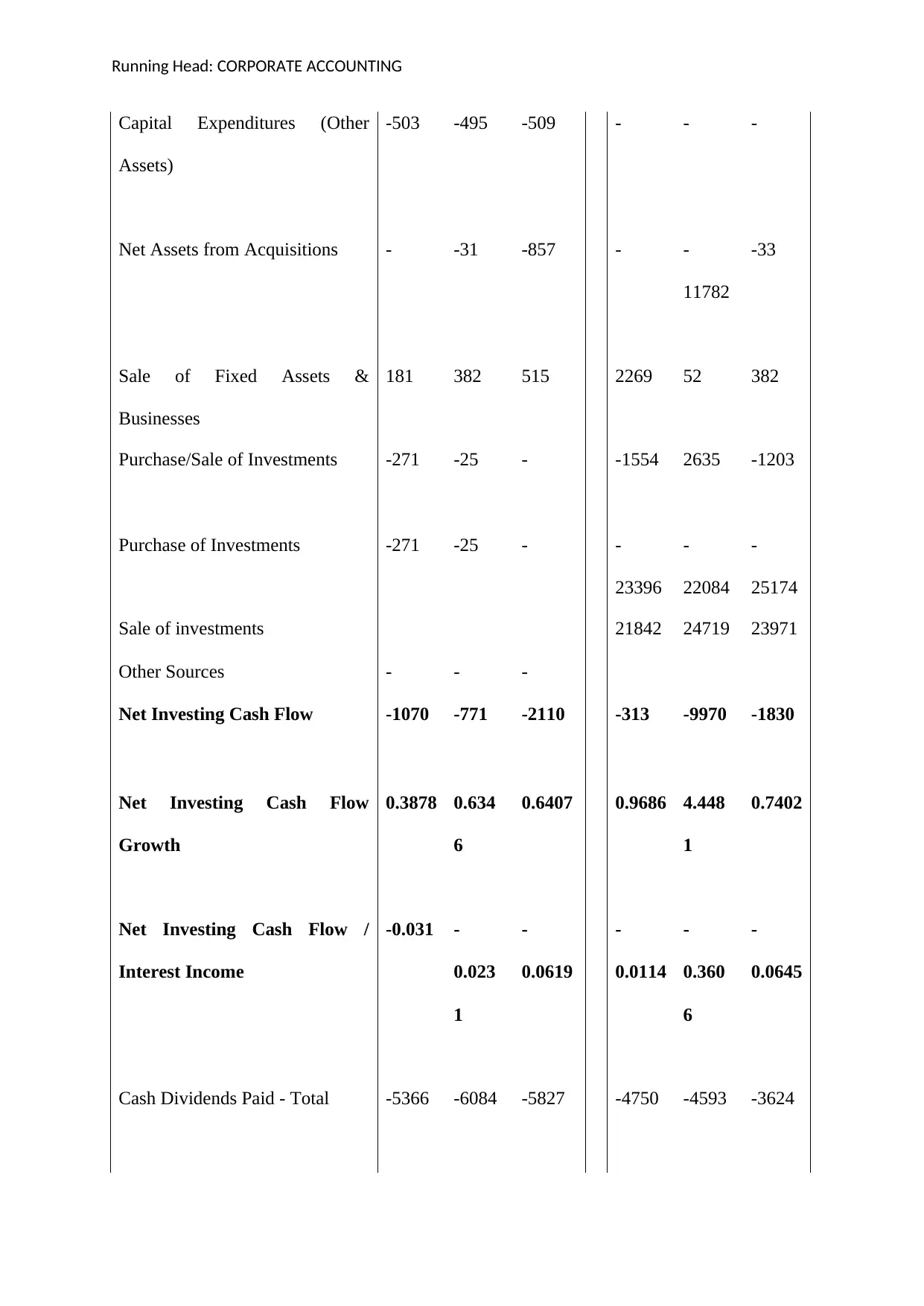
Running Head: CORPORATE ACCOUNTING
Capital Expenditures (Other
Assets)
-503 -495 -509 - - -
Net Assets from Acquisitions - -31 -857 - -
11782
-33
Sale of Fixed Assets &
Businesses
181 382 515 2269 52 382
Purchase/Sale of Investments -271 -25 - -1554 2635 -1203
Purchase of Investments -271 -25 - -
23396
-
22084
-
25174
Sale of investments 21842 24719 23971
Other Sources - - -
Net Investing Cash Flow -1070 -771 -2110 -313 -9970 -1830
Net Investing Cash Flow
Growth
0.3878 0.634
6
0.6407 0.9686 4.448
1
0.7402
Net Investing Cash Flow /
Interest Income
-0.031 -
0.023
1
-
0.0619
-
0.0114
-
0.360
6
-
0.0645
Cash Dividends Paid - Total -5366 -6084 -5827 -4750 -4593 -3624
Capital Expenditures (Other
Assets)
-503 -495 -509 - - -
Net Assets from Acquisitions - -31 -857 - -
11782
-33
Sale of Fixed Assets &
Businesses
181 382 515 2269 52 382
Purchase/Sale of Investments -271 -25 - -1554 2635 -1203
Purchase of Investments -271 -25 - -
23396
-
22084
-
25174
Sale of investments 21842 24719 23971
Other Sources - - -
Net Investing Cash Flow -1070 -771 -2110 -313 -9970 -1830
Net Investing Cash Flow
Growth
0.3878 0.634
6
0.6407 0.9686 4.448
1
0.7402
Net Investing Cash Flow /
Interest Income
-0.031 -
0.023
1
-
0.0619
-
0.0114
-
0.360
6
-
0.0645
Cash Dividends Paid - Total -5366 -6084 -5827 -4750 -4593 -3624
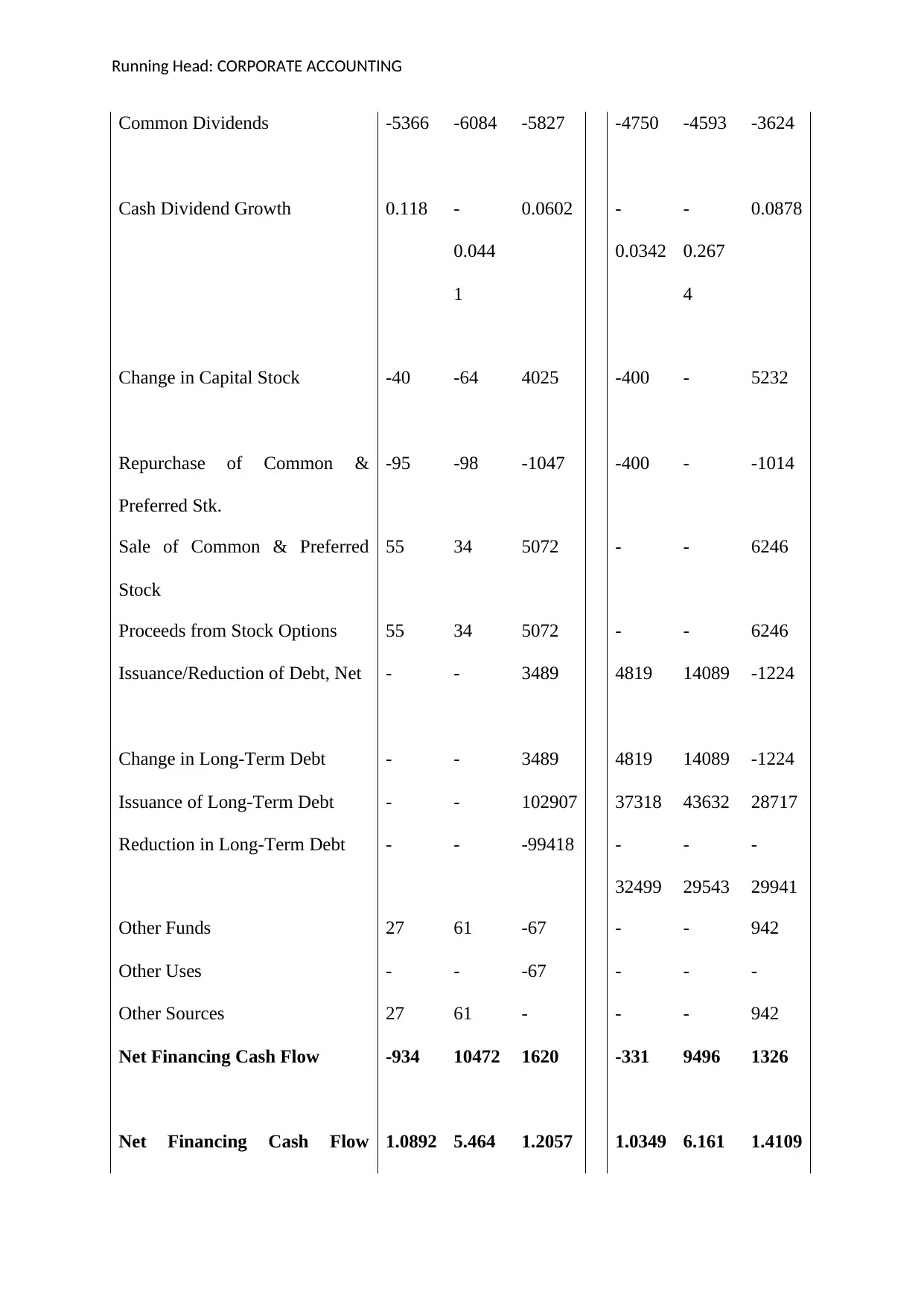
Running Head: CORPORATE ACCOUNTING
Common Dividends -5366 -6084 -5827 -4750 -4593 -3624
Cash Dividend Growth 0.118 -
0.044
1
0.0602 -
0.0342
-
0.267
4
0.0878
Change in Capital Stock -40 -64 4025 -400 - 5232
Repurchase of Common &
Preferred Stk.
-95 -98 -1047 -400 - -1014
Sale of Common & Preferred
Stock
55 34 5072 - - 6246
Proceeds from Stock Options 55 34 5072 - - 6246
Issuance/Reduction of Debt, Net - - 3489 4819 14089 -1224
Change in Long-Term Debt - - 3489 4819 14089 -1224
Issuance of Long-Term Debt - - 102907 37318 43632 28717
Reduction in Long-Term Debt - - -99418 -
32499
-
29543
-
29941
Other Funds 27 61 -67 - - 942
Other Uses - - -67 - - -
Other Sources 27 61 - - - 942
Net Financing Cash Flow -934 10472 1620 -331 9496 1326
Net Financing Cash Flow 1.0892 5.464 1.2057 1.0349 6.161 1.4109
Common Dividends -5366 -6084 -5827 -4750 -4593 -3624
Cash Dividend Growth 0.118 -
0.044
1
0.0602 -
0.0342
-
0.267
4
0.0878
Change in Capital Stock -40 -64 4025 -400 - 5232
Repurchase of Common &
Preferred Stk.
-95 -98 -1047 -400 - -1014
Sale of Common & Preferred
Stock
55 34 5072 - - 6246
Proceeds from Stock Options 55 34 5072 - - 6246
Issuance/Reduction of Debt, Net - - 3489 4819 14089 -1224
Change in Long-Term Debt - - 3489 4819 14089 -1224
Issuance of Long-Term Debt - - 102907 37318 43632 28717
Reduction in Long-Term Debt - - -99418 -
32499
-
29543
-
29941
Other Funds 27 61 -67 - - 942
Other Uses - - -67 - - -
Other Sources 27 61 - - - 942
Net Financing Cash Flow -934 10472 1620 -331 9496 1326
Net Financing Cash Flow 1.0892 5.464 1.2057 1.0349 6.161 1.4109
⊘ This is a preview!⊘
Do you want full access?
Subscribe today to unlock all pages.

Trusted by 1+ million students worldwide
1 out of 23
Related Documents
Your All-in-One AI-Powered Toolkit for Academic Success.
+13062052269
info@desklib.com
Available 24*7 on WhatsApp / Email
![[object Object]](/_next/static/media/star-bottom.7253800d.svg)
Unlock your academic potential
Copyright © 2020–2025 A2Z Services. All Rights Reserved. Developed and managed by ZUCOL.



